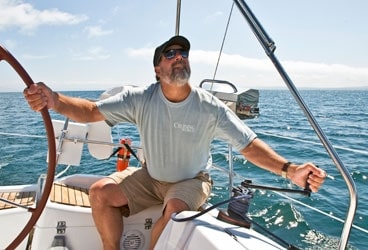
mark pillsbury headshot 1 368
Any time a late-summer tropical storm has a forecast track somewhere to the left of Bermuda, I can’t help but take notice. And if the five-day cone posted by the National Hurricane Center includes most of the Eastern Seaboard from Cape Hatteras to Halifax, I figure we in New England are at best in for an inconvenience, and quite possibly for a royal pain in the you-know-what. So, ordinarily, a storm warning-or even a watch-is a call to action that has me scurrying to strip off sails and double up my pendant lines. But in August, with Hurricane Bill chugging up the coast and forecast to pass somewhere near Cape Cod, albeit in some diminished manner, I found that I was instead going sailing.
“What are you, nuts?” you ask. I inquired the same. Several times. But I’d been invited to join the crew of Brutus, a well-equipped and -sailed J/120 entered in the Ida Lewis Yacht Club’s Distance Race. And suspecting that a last-minute mutiny wouldn’t be treated lightly, I concluded that if the race was on, I had no choice but to be there for Friday’s 3 p.m. start. The course was to be a 150-mile ramble that would take us from Newport, Rhode Island, to a buoy off Montauk, New York, then to another mark near Martha’s Vineyard before dragging us back by Block Island and home to Newport. In the Wednesday-afternoon update, forecasters predicted that gale- to storm-force winds could lash the outer waters, especially near Cape Cod, by Saturday evening and seas would grow impressively over just about the entire period we could expect to be at sea. Two others in our office would also be out on boats for the race, and it occurred to at least a couple of us that a whole lot could go wrong, all for the sake of being able to say, “Been there, done that.”
By Thursday, the conditions were looking downright bleak, but then, thankfully, during the skippers meeting that evening, 50 miles were trimmed off the course, meaning that if all went well, we’d be back at the dock long before things turned truly ugly. Modern forecasts are a wonderful thing for sailors and race committees alike. By contrast, I was at that point editing one of the stories for this month’s Safety at Sea section, a first-person account of the Fastnet storm of 30 years ago that caught a racing fleet unawares and resulted in the tragic loss of 19 sailors. (See “In the Eye of the Storm,” page 50.)
Ironically, while the race committee debated the change in course, I was having supper with Off Watch/Osprey’s Flight columnist Wendy Mitman Clarke and her family. They’d been exploring Maine and were sailing south, heading off to who knows where. As we sat at the Black Pearl, we nervously brought up the approaching weather, and she and her husband, Johnny, talked about GRIB files showing the storm tracking farther west, closer to us. Fulltime liveaboards, they weren’t taking chances and planned to leave the next morning to get Osprey securely anchored in one of Narragansett Bay’s bulletproof hurricane holes.
“Good luck with that storm,” they said as we went off on separate tacks.
Race day dawned humid as hell, but by afternoon, the heavy fog that had clung to the coast for days started to lift. Near Castle Hill, the swells pouring into the bay were manageable enough. By evening, we passed Block Island on our way out. The fog enveloped us briefly but then disappeared, leaving a star-splashed night. With a spinnaker set, we rushed down waves until dawn, watching lightning far off over the land and thrilled by the ride.
In the end, it was a near-perfect night to be on a boat and sailing. And it’s one I’ll remember for a long, long time. But I still wonder if Wendy and Johnny weren’t the more prudent mariners.
Mark Pillsbury







